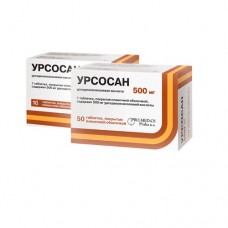Expiration date: 04/2026
Hepatoprotective tool also has choleretic, cholelitolitic, hypolipidemic, hypocholesterolemic and immunomodulatory effects.
With high polar properties, ursodeoxycholic acid (UDCA) is embedded in the membrane of hepatocytes, cholangiocyte and epitheliocyte gastrointestinal tract, stabilizes its structure and protects the cell from the damaging effects of toxic salts of bile acids, thus reducing their cytotoxic effect. Forms a non-toxic mixed micelles with a lipophilic (toxic) bile acids, which reduces the ability of gastric reluctate to damage of the cell membrane in cholestatic liver diseases, biliary reflux-gastritis and reflux-esophagitis.
When cholestasis UDCA activates Ca2+-dependent alpha-protease and stimulates exocytosis, reduces the concentration of toxic bile acids (henodezoksiholevoy, lithocholic, deoxycholic, etc.), the concentration of which in patients with chronic liver diseases increased. Reducing their concentration and stimulating holert, rich in bicarbonates, UDCA effectively contributes to the resolution of intrahepatic cholestasis. Competition reduces the absorption of lipophilic bile acids in the intestines, promotes their "fractional" turnover at the enterohepatic circulation, induces holert, stimulates the passage of bile and the excretion of toxic bile acids through the intestines.
Reduces the saturation of bile with cholesterol due to inhibition of its absorption in the intestine and suppressing synthesis in the liver and reduce the secretion into the bile; contributes to the gradual dissolution of cholesterol gallstones, which is achieved mainly due to the dispersion of cholesterol and formation of liquid crystals; reduces the lithogenic index of bile increases it concentration of bile acids. The result is the dissolution of cholesterol gallstones and prevention of formation of new stones.
Causes increased gastric and pancreatic secretion, enhances the activity of lipase, has a hypoglycemic effect.
Immunomodulatory effect of UDCA is due to inhibition of expression of histocompatibility antigens – HLA-1 on the membranes of hepatocytes and HLA-2 – cholangiocyte, normalization of natural killer activity of lymphocytes, formation of interleukin-2, a decrease in the number of eosinophils, suppression of immune immunoglobulins (Ig), primarily IgM; regulation of apoptosis of hepatocytes and epithelial cells of the gastrointestinal tract. Delays the progression of fibrosis.
Pharmacokinetics
UDCA is absorbed in the jejunum and upper part of the ileum by passive diffusion (90 %), and in the terminal divisions of the ileum through active transport. The rate of resorption is usually 60-80 %.
The ingestion of 50 mg UDCA maximum concentration in plasma (Cmax) after 30, 60, 90 minutes is 3.8 mmol/l 5.5 mmol/l and 3.7 mmol/l, respectively. The time to maximum plasma concentration (Dmah) occurs in 1-3 hours. Connection with plasma proteins is high – up to 96-99 %. Penetrates through the placental barrier.
The systematic administration of the drug UDCA becomes the major bile acid in the serum. Metabolized in the liver (clearance at the "primary passage" through the liver is 60 %) in taurine and glycine conjugates. The resulting conjugates are secreted into bile. About 50-70 % of the total dose is excreted in the bile. A small amount is not absorbed in the small intestine UDCA enters the large intestine, where it undergoes cleavage by bacteria (7-dihydroxyflavone); litojolevu acid formed is partially absorbed from the colon, sulfatides in the liver and quickly excreted in the bile in the form sulfamethazine or sulfatecontaining conjugate.
Indications:
- Uncomplicated gallstone disease (GSD): biliarylike; dissolution of cholesterol gallstones in a functioning gallbladder; prevention of recurrence of stone formation after cholecystectomy
- Chronic hepatitis of various Genesis (toxic, drug, etc.)
- Cholestatic liver diseases of different Genesis, including primary biliary cirrhosis, primary sclerosing cholangitis, cystic fibrosis (cystic fibrosis)
- Non-alcoholic fatty liver disease, including alcohol-tion steatohepatitis
- Alcoholic liver disease
- Viral hepatitis chronic
- Biliary dyskinesia
- Biliary reflux-gastritis and reflux-esophagitis
Contraindications
- Hypersensitivity to the active and auxiliary components of the drug;
- roentgenologically (high in calcium) gall stones;
- non-functioning gall bladder;
- acute inflammatory diseases of the gall bladder, bile ducts and intestines;
- liver cirrhosis in the decompensation stage;
- expressed by the human kidney, liver, pancreas.
Ursodeoxycholic acid has no age restrictions in application, however, children under the age of 3 years are not recommended to use the drug in this dosage form.




